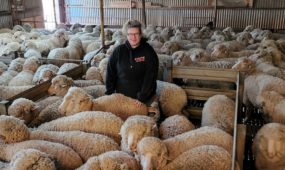Cellar doors drive boutique winery growth in Australia
Primary Industries
CELLAR door and mail order sales are driving strong growth for small wineries, the latest survey results published by Wine Australia has found.

Sign up to receive notifications about new stories in this category.
Thank you for subscribing to story notifications.
The trend is helping producers with estimated annual crushes of less than 500 tonnes make inroads into a market dominated by huge wine companies in recent decades.
Small winemaking businesses generated $1.1 billion in wine sales revenue in 2015–16, an average increase of 12 per cent, according to the Small Winemaker Production and Sales Survey 2016 released this week by Wine Australia in South Australia.
While retailers and wholesalers generated 47 per cent of income for small producers, cellar doors have become increasingly important sales channels, accounting for 29 per cent of domestic sales. Cellar door and mail order channels showed the largest growth, both increasing by 7 per cent for the 12-month period.
Barossa Valley producer Whistler Wines crushes about 100 tonnes a year, producing about 6000 cases. It relies on about 10 food and music themed events a year in its native Australian bush setting coupled with regular cellar door traffic to attract visitors.
Owner, grapegrower and winemaker Josh Pfeiffer said using winery events and the cellar door to reach new customers and build a database of clients was crucial.
He said being able to offer something different that wasn’t widely available elsewhere and reflected the provenance of the region appealed to visitors.
“We get people coming in here every day saying they are only interested in coming to small independent wineries – they want to meet the people behind the wine and learn something,” he said.
“That’s translating across the trade as well, where wine buyers from restaurants and hotels are wanting independent, smaller brands on their lists and customers of theirs are requesting that as well.
“It’s the same in retail too with the smaller independent bottle shops.”
According to the Wine Australia report, small wineries only exported about 12 per cent of their wine, which is consistent with Whistler Wines’ experience, while exports made up more than 60 per cent of Australian wine sales industry wide.
Pfeiffer said once people had visited the Barossa cellar door they were encouraged to join the 10,000-strong mailing list where they were given access to online specials.
“For us it’s about getting people here and then keeping them here for long enough for them to remember us and want to come back,” he said.
“We do 70 per cent of our sales direct to customers and that’s one of the only reasons we are able to survive.
“If we were giving away 35 per cent to distributors or selling wholesale then all of a sudden you’re not making the margin that you need to make.”
Association of Australian Boutique Winemakers CEO Judith Kennedy said cellar door and mail order sales helped small wine companies maintain margins and bypassed the challenges some faced of securing distribution in major cities.
She said the ability to value add to a wine business through gift sales, accommodation and eateries attached to cellar doors also provided opportunities for new revenue streams.
“It can take a long time for a little wine company to become profitable but cellar doors are certainly part of the answer,” Kennedy said.
“People love the experience of actually being there, talking with the winemaker if they’re lucky and talking with the people who have had hands on experience with the wine.
“The cellar door industry in general is more buoyant now than ever.”
Research released in 2015 by the University of South Australia’s Ehrenberg Bass Institute found that a visit to a winery's cellar door had a lasting effect on consumer behaviour, influencing their buying habits for months afterwards.
“If they like the wine and they’re OK with the price then they’ll join the mailing list and they’ll buy the wine on a regular basis,” Kennedy said.
“As their volumes increase and they have a few good harvests they put the money into improving their cellar doors.
“Sometimes you’ll find tremendously humble little cellar doors and you go back there five years later and they’ve got this beautiful establishment and a line of people going out the door.”
The 223 survey responses from Australian small wine businesses also found:
Production was up 7 per cent, with the highest average growth in wineries that produce 70,001–170,000 litres (8000–20,000 cases) (up 11 per cent). Average revenue growth was 12 per cent in 2015–16. Nearly half (48 per cent) of the wineries surveyed make all of their wine in their own facilities. On average, two-thirds of grapes used by small wineries were grown in their own vineyards.
South Australia produced 51 per cent of the nation’s crush in 2016 and about 75 per cent of Australia’s premium wine from some of the oldest vines in the world.
Its 18 regions include the Barossa Valley, which is home to iconic brands such as Penfolds Grange, Jacob’s Creek and Wolf Blass.
Jump to next article



